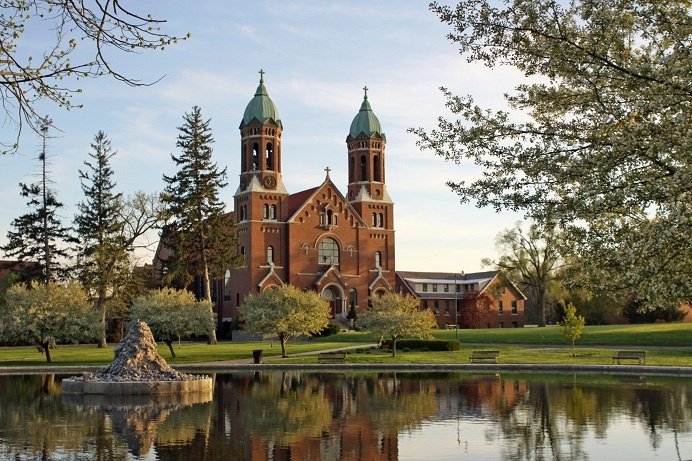According to US Bureau of Labor Statistics, 65.9% of high school seniors will go on to start college every fall in the US. They will enter universities, colleges, community colleges and more. In every single case they, many times with the help of their parents, will have to navigate the process of selecting colleges to apply for, manage being accepted, choosing a school to attend and ultimately enrolling at their choice. Aside from that most will apply for some form of Financial Aid and fill out the FAFSA form to find out what their real cost will be. It is quite a process!
The old days.
According to US Bureau of Labor Statistics, 65.9% of high school seniors will go on to start college every fall in the US. They will enter universities, colleges, community colleges and more. In every single case they, many times with the help of their parents, will have to navigate the process of selecting colleges to apply for, manage being accepted, choosing a school to attend and ultimately enrolling at their choice. Aside from that most will apply for some form of Financial Aid and fill out the FAFSA form to find out what their real cost will be. It is quite a process!
My Dad, Stan Dworak, was the first in his family to attend college in the early 1960’s at St. Joseph’s College in Rensselaer, Indiana. His father, my grandfather, thought he was crazy for attending college when he could have gotten a great job working for the family company, Dworak Trucking in Chicago. Because my grandfather did not go to college he did not have a vision for post-secondary education like my Dad did. My Dad knew the trajectory of his life would change if he went to college, both from a social and economic perspective. He would often recall the story of his Dad dropping him off for school and not offering much in the way of support.
My Dad recalled his freshman orientation and the Dean telling everyone to look at the people to their right and to their left and that many of the people they were looking at would not be next to them at graduation. A tough, but maybe realistic view of retention and student success in 1960. He was determined not to be one of the people that dropped out, and he didn’t – he made it and graduated 4 years later with a job lined up at Sears as a management trainee. He rode the Sears train for 30 more years and took a generous buyout/early retirement offer at 55 and never worked full-time again. My Dad, who passed away too early in 2004, put himself through school and changed his life trajectory, and ultimately, his families as well by investing in himself through going to college.
He never said much to us about college growing up, but I am quite sure the systems were a bit simpler than they are today. My Dad did whatever it took to make sure he was registered for classes, had his bills paid and whatever else was required of him as a student – without the help of his parents.
While the times may have been a bit simpler in the 60’s, the times have most certainly changed.

My university experience.
Fast forward to the summer of 1993. After a lackluster high school career, I had to figure out where I would go to college in a few months time. My parents told me they would help me with tuition if I went to the local community college, College of Dupage. If I wanted to go anywhere else, it would be on me to pay for it. Choosing COD was an easy choice. It was a fall back option for people who hadn’t figured out where they wanted to go, or couldn’t get into a better college right out of high school.
COD was a perfect fit for me. Registering for classes was done in person and wasn’t that complicated to figure out using a printed catalog which classes to take. It wasn’t intimidating and the registrar’s office was really helpful in getting me admitted and signed up for classes in about an hour. After that, I spent two years working hard and making the President’s list multiple times and finally getting my academic act together. From there, by word of mouth, I decided to attend Bethel University in St. Paul, MN. I reached out by phone and asked for an application – I applied, was accepted and was ready to go. This whole process took about 2 months. Bethel had an event in the Chicagoland area during the second semester of my last year at COD and I was able to go, register for classes, and pick out my housing for the next year. Once I got to Bethel things were pretty informal and easy to navigate because it was a small school and the staff went out of their way to help you get connected to what you needed to get connected to. Almost no one had cell phones and the internet was a novelty more than anything in 1995. Email was available but not really used for anything academic, more just for keeping in touch with friends at other colleges. I went on to graduate from Bethel with a solid liberal arts degree in History which taught me how to think and write – both things that have served me everywhere I have worked. There were services at the college that I had no idea existed – I could have certainly benefited from knowing some of those offices, like career services, were there to help me succeed. Word of mouth had its limitations.
The current university experience.
Fast forward a lot of years and my niece, Taylor, began navigating the college selection process for a number of years before she ended up at Indiana University this past fall. Taylor visited many Big Ten schools before finally applying and being accepted to Indiana University. The focus on going to college at her high school was intense and prepared her to make the leap to college. She has done a great job of navigating a big school as a freshman and is an aspiring business person who will no doubt do well in her career once she graduates. Cell phones are now default appendages for the college student of today – they are constantly connected and have multiple ways to connect to everyone they know at any time. Yet, many college students report being lonely despite this constant connection. Navigating colleges and their systems is more complicated than ever.
I can only imagine what the college process will look like for my 8 year old, or 3 year old in 8-12 years.
Looking back on the past and future of higher education, as a student, administrator and now doing business development for an EdTech company, Campus, has allowed me a unique perspective. Trying to look through the eyes of my father and now my niece has expanded my view of the higher education journey.
A few lessons learned.
- Navigating the process of finding, enrolling and graduating from school continues to grow more complicated and expensive to where college continues to become out of reach for more and more high school students.
- Colleges have to figure out how to do more with less as they cannot just keep raising tuition like the good old days. This will require more and more technological innovation despite the fact that a lot of innovation is not welcomed by many faculty at those colleges.
- In the 1960’s you needed college – they didn’t need you.
- In the 1990’s colleges were happy to have you and there were a lot of you.
- In 2017, colleges need you and more than ever and more people are choosing to skip college at a higher rate than in the past 30 years.
- While the use of technology during the college process is increasing, often higher education is so far behind in technology it can become a burden to students rather than a help. This has to change.
At Campus, we are passionate about bringing together the university around a student, making it easier for students to connect and interact with their university community. While just one part of the higher education student success Ed-Tech scene – we want to do our part to help students be successful.
We would love to talk to you about your school and what you are doing with technology around student success and engagement. Please reach out if there is any way we can help!
